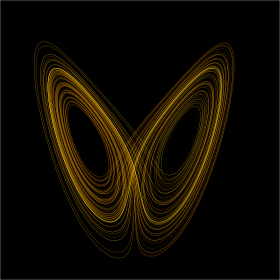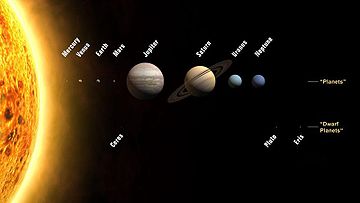Portal:Systems science/Picture
Picture 1
Portal:Systems science/Picture/1

The Lorenz attractor is a 3-dimensional structure corresponding to the long-term behavior of a chaotic flow, noted for its butterfly shape. The map shows how the state of a dynamical system (the three variables of a three-dimensional system) evolves over time in a complex, non-repeating pattern.
The attractor itself, and the equations from which it is derived, were introduced by Edward Lorenz in 1963, who derived it from the simplified equations of convection rolls arising in the equations of the atmosphere.
Picture 2
Portal:Systems science/Picture/2

Systems engineering techniques are used in complex projects: from spacecraft to chip design, from robotics to creating large software products to building bridges, Systems engineering uses a host of tools that include modeling & simulation, requirements analysis, and scheduling to manage complexity.
Picture 3
Portal:Systems science/Picture/3

The Work Breakdown Structure (WBS) is a means of organizing system development activities based on system and product decompositions. The systems engineering process produces system and product descriptions. These product architectures, together with associated services (e.g., program management, systems engineering, etc.) are organized and depicted in a hierarchical tree-like structure that is the WBS.
Picture 4
Portal:Systems science/Picture/4

This image illustrates part of the Mandelbrot set fractal. The size of the JPEG file encoding the bitmap of this image is more than 17 kilobytes (approximately 140000 bits). The same file can be generated by a computer program much shorter than 140000 bits, however. Thus, the Kolmogorov complexity of the JPEG file encoding the bitmap is much less than 140000.
Picture 5
Portal:Systems science/Picture/5

An ecological analysis of CO-2 in an ecosystem. As systems biology, systems ecology seeks a holistic view of the interactions and transactions within and between biological and ecological systems.
Picture 6
Portal:Systems science/Picture/6

Picture 7
Portal:Systems science/Picture/7

Turbulence in the tip vortex from an airplane wing. Studies of the critical point beyond which a system creates turbulence was important for Chaos theory, analyzed for example by the Soviet physicist Lev Landau who developed the Landau-Hopf theory of turbulence. David Ruelle and Floris Takens later predicted, against Landau, that fluid turbulence could develop through a strange attractor, a main concept of chaos theory.
Picture 8
Portal:Systems science/Picture/8

An aerial view of a human ecosystem. Pictured is the city of Chicago.
Picture 9
Picture 10
Portal:Systems science/Picture/10

Planets and dwarf planets of the Solar System; while the sizes are to scale, the relative distances from the Sun are not.
Picture 32
Portal:Systems science/Picture/32

Francis Galton was an English polymath known for his work in heredity, eugenics, and statistics. This photograph of Galton (age 73) was created upon his visit to Alphonse Bertillon's anthropometry laboratory in 1893. It serves as a good example of Bertillon's identification technology, which intended for the prosecution of criminals. Ironically, fingerprinting, a technique Galton transformed into a rigorously scientific one, eventually replaced Bertillon's system.

